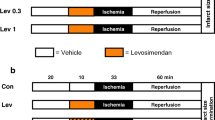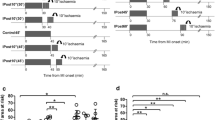Abstract
Objectives
The postulate that ischemic preconditioning caused an attenuation in ischemia induced increases in tissue cAMP, and that this may pertain to the mechanism of ischemic preconditioning, was investigated in the isolated rat heart. A significant reduction in tissue cAMP in preconditioned hearts was observed for all time periods of global ischemia studied. The significance of this observation was evaluated by comparing the effect of antiadrenergic interventions on energy metabolism and post-ischemic functional recovery of both non-preconditioned and preconditioned hearts.
Methods
The isolated perfused rat heart was used as experimental model. Six groups were studied: Non-preconditioned rat hearts: i) untreated controls (Non-PC), ii) reserpinised (Non-PC Res), iii) propranolol treated (10−7M) (Non-PC Prop); Preconditioned rat hearts: iv) preconditioned controls (PC), v) reserpinised (PC Res) and vi) propranolol (10−7M) treated (PC Prop).
Results
After 25 min global ischemia the concentration of cAMP was increased by 79.6% in the Non-PC group. This increase was attenuated in all of the treated groups, although in varying degrees. Energy utilization in these hearts also differed markedly between the groups. Functional recovery was however similar in all Non-PC and PC treated groups and significantly superior to that of Non-PC control hearts. Prior reserpinisation mimicked the protective effect of preconditioning on energy metabolism and functional recovery. To determine the significance of attenuation of the increase in cAMP in the protection conferred by preconditioning, hearts were pretreated with forskolin (10−6M). This caused an accumulation of tissue cAMP in preconditioned hearts to similar absolute values as seen in untreated non-preconditioned hearts during 25 min global ischemia. However, the percentage increase in forskolin-pretreated preconditioned hearts during sustained, ischemia was only 50% vs. 71% in non-preconditioned hearts treated with forskolin, confirming an attenuated β-response induced by preconditioning. Forskolin treatment of preconditioned hearts did not abolish the protective effect.
Conclusions
The findings suggest that the protection against ischemic damage conferred by preconditioning is associated with an attenuated β-adrenergic response. However, whether the changes in cAMP occurring during sustained global ischemia is the cause or consequence of the elicited protection, remains to be established.
Similar content being viewed by others
References
Armitage P, Berry G (1987) Statistical Methods in Medical Research, 2nd ed. Oxford: Blackwell Scientific Publications: 200–201
Asimakis GK, Inners-McBride K (1993) Attenuated postischemic contractile dysfunction associated with ischemic preconditioning is not mediated by alpha1 adrenoreceptor stimulation (abstract). Circulation 88 (Suppl): I-43
Asimakis GK, Inners-McBride K, Medellin G, Conti V (1992) Ischemic preconditioning attenuates acidosis and postischemic dysfunction in isolated rat heart. Am J Physiol 163: H887-H894
Banerjee A, Locke-Winter C, Rogers K, Mitchell MB, Brew EC, Cairns C, Bensard D, Harken AH (1993) Preconditioning against myocardial dysfunction after ischaemia and reperfusion by an α-1 adrenergic mechanism. Circ Res 73: 656–670
Corr PB, Witkowski FX, Sobel BE (1978) Mechanisms contributing to malignant dysrhythmias induced by ischemia in the cat. J Clin Invest 61: 109–119
Edoute Y, Graney D, Sanan D, Kotze JCN, Lochner, A (1981) Effects of propranolol on mitochondrial ultrastructure, mitochondrial function and high energy phosphates of working rat hearts with coronary artery ligation. J Mol Cell Cardiol 13: 619–639
Fu L-X, Kirkeboen KA, Liang Q-M, Sjoegren K-G, Hjalmarson A, Ilebek A (1993) Free radical scavenging enzymes and G protein mediated receptor signalling systems in ischaemically preconditioned porcine myocardium. Cardiovascular Res 27: 612–616
Hearse DJ, Yellon DM, Downey JM (1986) Can beta-blockers limit myocardial infarct size? Eur Heart J 7: 925–930
Iwase T, Murakami T, Tomita T, Miki S, Nagai K, Sasayama S (1993) Ischemic preconditioning is associated with a delay in ischemia-induced reduction of β-adrenergic signal transduction in rabbit hearts. Circulation 88: 2827–2837
Komori S, Szekeres, L, Parratt JR (1990) Preconditioning reduces the severity of ischemia and reperfusion-induced arrhythmias in both anesthetized rats and dogs. J Physiol 423: 16P
Liu YL, Downey JM (1992) Ischaemic preconditioning protects against infarction in rat heart. Am J Physiol 263 (Heart Circ Physiol 32): H1107-H1112
Liu GS, Thornton J, Van Winkle DM, Stanley AWH, Olsson RA, Downey JM (1991) Protection against infarction afforded by preconditioning is mediated by A-1 adenosine receptors in rabbit heart. Circulation 84: 350–356
Mitchell MB, Meng X, Ao L, Brown JM, Harken AH, Banerjee A (1995) Preconditioning of isolated rat heart is mediated by protein kinase C. Circ Res 76: 73–81
Moolman JA, Genade S, Winterbach R, Harper IS, Williams K, Lochner A (1995) Preconditioning with a single episode of ischemia in the isolated working rat heart: effect on structure, mechanical function and energy metabolism for various durations of sustained ischemia. Cardiovasc Drugs Ther 9: 103–115
Muller CA, Opie LH, Hamm CW, Peisach M, Ghiwala D, Steyn JM, Basset (1986) Prevention of ventricular fibrillation by metoprolol in a pig model of acute myocardial ischaemia: absence of a major arrhythmogenic role for cyclic AMP. J Mol Cell Cardiol 18: 375–387
Murry CE, Jennings RB, Reimer KA (1986) Preconditioning with ischemia: a delay of lethal cell injury in ischemic myocardium. Circulation 74: 1124–1136
Murry CE, Richard VJ, Reimer KA, Jennings RB (1990) Ischemic preconditioning slows energy metabolism and delays ultrastructural damage during a sustained ischemic episode. Circ Res 66: 913–931
Niromaand F, Weinbrenner C, Weis A, Bangert M, Schwenke C, Marquetant R, Beyer T, Strasser R, Kübler W, Rauch B (1995) Impaired function of inhibitory G proteins during acute myocardial ischemia of canine hearts and its reversal during reperfusion and a second period of ischemia. Circ Res 76: 861–870
Podzuweit T, Els DJ, McCarthy J (1981) Cyclic AMP mediated arrhythmias induced in the ischaemic pig heart. Basic Res Cardiol 76: 443–448
Podzuweit T, Nennstiel P, Bader R, Müller A (1994) Ischaemia causes inhibition of cyclic nucleotide phosphodiesterases (abstract). J Mol Cell Cardiol 26: CXVI
Podzuweit T, Thomas S, Binz K, Muller A (1995) Protective mechanisms 2. IP attenuates ischaemia-induced PDE inhibition (abstract). J Mol Cell Cardiol 27: A161
Rona G (1985) Catecholamine cardiotoxicity. J Mol Cell Cardiol 17: 291–306
Sandhu R, Diaz RJ, Thomas U, Wilson GJ (1993) The effect of ischemic preconditioning on cAMP levels in rabbit hearts (abstract). J Mol Cell Cardiol 25: (Suppl III): S62
Sandhu R, Diaz RH, Wilson GH (1994) Raising cAMP levels with forskolin does not block ischemic preconditioning (abstract). J Mol Cell Cardiol 26: CLXXXIV
Sandhu R, Thomas U, Diaz RJ, Wilson GJ (1995) Mechanism of reduced cAMP levels in ischemic preconditioned rabbit hearts (abstract). J Mol Cell Cardiol 27: A26
Sandhu R, Thomas U, Diaz RJ, Wilson GJ (1995) Ischemic preconditioning does not protect against necrosis through a reduction in cAMP levels (abstract). J Mol Cell Cardiol 27: A26
Seyfarth M, Münch G, Schreieck J, Kurz T, Richardt G, Schömig A (1994) Release of norepinephrine is suppressed by preconditioning in rat ischemic hearts. Circulation 90: I-108
Thornton JD, Daly JF, Cohen MV, Yang X, Downey JM (1993) Catecholamines can induce, adenosine receptor-mediated protection of the myocardium but do not participate in sichemic preconditioning in the rabbit. Circ Res 73: 549–655
Toombs CF, Wiltse AL, Shebuski RJ (1993) Ischemic preconditioning fails to limit infarct size in reserpinized rabbit myocardium. Circulation 88 (part 1): 2351–2358
Steenbergen C, Perlman ME, London RE, Murphy E (1993) Mechanism of Preconditioning. Ionic Alterations. Circ Res 72: 112–125
Strasser RH, Braun-Dullaeus R, Walendzik, H, Marquetant R (1992) α1-Receptor-independent activation of protein kinase C in acute myocardial ischaemia. Mechanisms for sensitization of the adenyl cyclase system. Circ Res 70: 1304–1312
Strasser RH, Krimmer J, Braun-Dullaeus R, Marquetant R, Kübler W (1990) Dual sensitization of the adrenergic system in early myocardial ischaemia: independent regulation of the β-adrenergic receptors and the adenylyl cyclase. J Mol Cell Cardiol 22: 1405–1423
Vandeplassche G, Lu HR, Wouters L, Flameng W, Borgers M (1991) Normothermic ischemic cardiac arrest in the isolated working rabbit heart: effects of dl-nebivolol and atenolol. Basic Res Cardiol 86: 21–31
Vander Heide RS, Jennings RB, Reimer KJ (1993) Catecholamines are not required for ischemic preconditioning in canine myocardium (abstract). Circulation 88 (Suppl): I-101
Volovsek A, Subramanian R, Rebousoin D (1992) Effects of duration of ischaemia during preconditioning on mechanical function, enzyme release and energy production in the isolated working rat heart. J Mol Cell Cardiol 24: 1011–1019
Weselcouch E, Baird AJ, Sleph PG, Dzwonkzyk S, Murray HN, Grover GJ (1995) Endogenous catecholamines are not necessary for ischaemic preconditioning in the isolated perfused rat heart. Cardiovasc Res 29: 126–132
Wolfe CL, Sievers RE, Visseren FLJ, Donnelly TJ (1993) Loss of myocardial protection after preconditioning correlates with the time course of glycogen recovery within the preconditioned segment. Circ 87: 881–892
Wollenberger A, Krause EG (1968) Metabolic control characteristics of the acutely ischemic myocardium. Am J Cardiol 22: 349–359
Wollenberger A, Krause EG, Shahab L (1967) Endogenous catecholamine mobilization and the shift to anaerobic energy production in the acutely ischemic myocardium. International symposium on coronary circulation and energetics of the myocardium. Basel; Karger: 200–219
Worthington MG, Opie LH (1992) Contrasting effects of cyclic AMP increase caused by β-adrenergic stimulation or by adenylate cyclase activation on ventricular fibrillation threshold of isolated rat heart. J Cardiovasc Pharmacol 20: 595–600
Ytrehus K, Liu Y, Downey JM (1994) Preconditioning protects ischemic rabbit heart by protein kinase C activation. Am J Physiol 286: H1145-H1152
Author information
Authors and Affiliations
Rights and permissions
About this article
Cite this article
Moolman, J.A., Genade, S., Tromp, E. et al. A comparison between ischemic preconditioning and anti-adrenergic interventions: cAMP, energy metabolism and functional recovery. Basic Res Cardiol 91, 219–233 (1996). https://doi.org/10.1007/BF00788908
Received:
Revised:
Accepted:
Issue Date:
DOI: https://doi.org/10.1007/BF00788908




